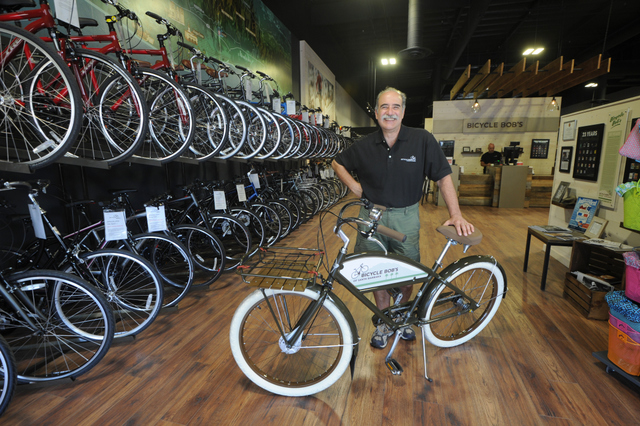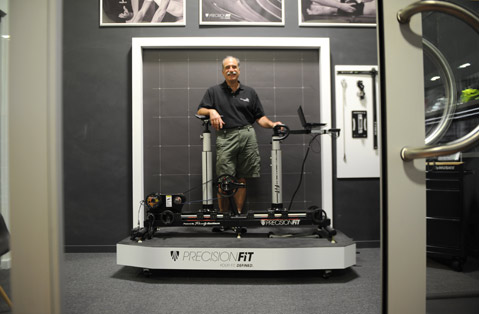Getting Fit at Bicycle Bob’s
New Trek Superstore Concept Boasts “Precision Fit”

I’m hypnotized watching a red laser beam bounce back and forth across my knee as I pedal on a stationary bike in a glass-walled sanctum tucked into the back corner of the new Bicycle Bob’s. In fact, general manager Jeremy Platt explains to me, the light isn’t moving at all. My knee is swinging side to side with every rotation of the pedal. He wiggles his elbows like he’s doing the chicken dance to demonstrate my wayward patella before taking off my cycling shoe, adjusting the cleat a few millimeters, and rechecking my alignment.
I’ve made a pilgrimage to Goleta to check out the new sprawling, 9,400-square-foot, state-of-the-art iteration of Bob Zaratzian’s 32-year-old retail bike business. This new Trek superstore replaces both former Bob’s locations on Storke Road and Upper State (which will be the new home of Velo Pro). Zaratzian said that when John Burke, the CEO of Trek and part-time Montecito resident, walked into one of the old shops, he remarked it was cutting edge — 15 years ago.
This new store is definitely sleek. The ceilings are high, the LED-lit displays are clean, and the décor is meticulously curated by Trek executives with spacious sections for kids’ bikes and women’s apparel. In the “Project One” area, iPads on stands allow hedge fund managers to design fully customized bicycles and punch their orders straight into the Trek bicycles factory. It’s all really cool, but one wonders if Zaratzian, a perennial winner of the bike shop category in The Santa Barbara Independent’s Best Of reader survey, hasn’t lost some of the mom-and-pop feel of his other stores, outdated as they may have been.

When I asked if I could take a test run in the Trek Precision Fit Room, valued at $14,000, I figured that it would make for a more interesting angle than explaining how Radius Commercial Real Estate helped Zaratzian close the deal on the defunct Lemos Feed & Pet Supply location and adjacent properties. What I found was that the technological crown jewel of Santa Barbara’s first bicycle “superstore” was also the source of personal attention that can elevate the retail experience above an exchange of money for goods.
I was cynical about receiving a “precision fit,” which costs $150. I’m no Taylor Phinney, but I’d been riding bikes long enough to feel like I’d mastered the fine network of angles and alignments that put one into an ideal position. However, Platt asked me a simple question that shook my confidence — whether I experience any pain when I ride my bike. No, of course not. Well, maybe. Actually, my trapezius always gets kind of sore. And when I ride more than 40 miles, my kneecap starts to throb. Which one? The left one. Go figure.
Before he let me hop onto the “Precision Fit” machine, Platt quizzed me on my health history and my riding habits. He tested my core strength and my flexibility. The machine itself resembles a stationary bike, but it allows for fine-tuning at every dimension so that with incremental adjustments, a fitter can find the customer’s ideal position. Some bike-fitting guidelines I was aware of: When your pedal is at three o’clock, for instance, your knee should be directly over the pedal spindle. Others, like the fact that your scapula should be directly over your bike’s bottom bracket, I learned during the fitting.
Platt explained that rules of thumb are just that; each body is different, and what he enjoys most is solving the puzzle of what works best for every cyclist. While the “fit room” makes the fitter’s job easier, it’s really the fitter that makes the difference. In the end, Platt does not make any drastic changes to my bike, but he notes my saddle is a bit too far forward and a tad too high. My handlebars are too low, given my less-than-impressive flexibility, and my saddle-to-handlebar reach a couple centimeters too long.
Platt, who trained at a cycling analysis center in Scottsdale, Arizona, called Cyclologic, says that $150 is easily worth the peace of mind it gives the average cyclist. He said that although he’s no doctor, his customers have reported noticeable reductions in pain from simple fixes. I admit that after I reconfigure my bike and do a couple of rides, I feel undeniably more comfortable and efficient.
This all goes to show that, in the age of the Internet, the brick-and-mortar bike shop still provides an unmatched retail experience, where competent guidance along with ongoing service can optimize the enjoyment of one’s purchase. Whether it be a neighborhood cruiser or a high-priced racing rig, once you pay for your bike, your bike will pay you back. So long as you ride it.



